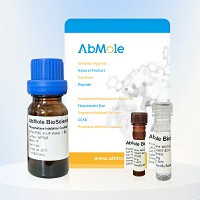
Species: Mouse
Expression system: E. coli
Purity: SDS-PAGE, > 95%
Endotoxin: protein < 0.2 EU/μg was determined by gel coagulation
Apparent molecular weight: ~ 9kda, sds-page under reduction conditions
Storage and stability: After receiving, the product remains stable at temperatures below -70°C for up to 6 months. After recombination, the product should be stable at 4°C for 1 week or -20°C for 3 months. For long-term preservation, carrier protein (e.g. 0.1% BSA) is recommended. Avoid repeated freeze-thaw cycles.
Biological activity: EC50 value of MOUSE IP-10 against Cho-K1 /Gα15/mCXCR3 cells (human Gα15 and mouse CXCR3 were stably expressed in Cho-K1 cells) was less than 2.0 μ G/mL. Other cell types expressing IP-10 include activated T lymphocytes, spleen cells, keratinocytes, osteoblasts, astrocytes, and smooth muscle cells. Ip-10 is also expressed in psoriasis and leprosy lesions. The mouse homolog crG-2 of human IP-10 has been cloned and shown to share approximately 67% of the amino acid sequence with human IP-10. This chemokine works by binding to the cell surface chemokine receptor CXCR3. Ip-10 is thought to have a variety of effects, such as attracting monocytes and T cells to chemotherapy, promoting T cell adhesion to endothelial cells, anti-tumor activity, and inhibiting bone marrow colony formation and angiogenesis.
| Solubility (25°C) | It is recommended that this vial be briefly centrifuged prior to opening to bring the contents to the bottom. Reconstitute the lyophilized powder in ddH₂O or PBS up to 100 μg/ml. |
| Storage |
Powder -20°C 3 years ; 4°C 2 years In solvent -80°C 6 months ; -20°C 1 month |
| Species | Mouse | Rat | Rabbit | Guinea pig | Hamster | Dog |
| Weight (kg) | 0.02 | 0.15 | 1.8 | 0.4 | 0.08 | 10 |
| Body Surface Area (m2) | 0.007 | 0.025 | 0.15 | 0.05 | 0.02 | 0.5 |
| Km factor | 3 | 6 | 12 | 8 | 5 | 20 |
| Animal A (mg/kg) = Animal B (mg/kg) multiplied by | Animal B Km |
| Animal A Km |
For example, to modify the dose of Compound A used for a mouse (20 mg/kg) to a dose based on the BSA for a rat, multiply 20 mg/kg by the Km factor for a mouse and then divide by the Km factor for a rat. This calculation results in a rat equivalent dose for Compound A of 10 mg/kg.
| Related Recombinant Proteins Products |
|---|
| Recombinant Human USP14 (E.coli, N-6His)
USP14 belongs to the ubiquitin-specific processing (USP) family which is a deubiquitinating enzyme (DUB) with His and Cys domains. USP14 acts also as a physiological inhibitor of endoplasmic reticulum-associated degradation (ERAD) under the non-stressed condition by inhibiting the degradation of unfolded endoplasmic reticulum proteins via interaction with ERN1. |
| Recombinant Human EpCAM/Trop-1 (Mammalian, C-Fc)
Epithelial Cell Adhesion Molecule (EpCAM) is a signal type I transmembrane glycoprotein. EpCAM plays a role in embryonic stem cells proliferation and differentiation; it up-regulates the expression of FABP5, MYC and Cyclin A and Cyclin E. It is highly and selectively expressed by undifferentiated embryonic stem cells. |
| Recombinant Human IL-36 gamma/IL-1 F9 Protein (E. coli, aa 18-169, His Tag)
The recombinant human IL1F9 consists of 168 amino acids and predicts a molecular mass of 19.1 KDa. A DNA sequence encoding the mature form of human IL1F9 (Ser18-Asp169) was expressed with a polyhistide tag at the N-terminus. |
| Recombinant Human IL-36 gamma/IL-1 F9 Protein (E. coli)
The recombinant human IL1F9 consisting of 169 amino acids and has a calculated molecular mass of 18.9 kDa. A DNA sequence encoding the human IL-1F9 isoform 1 (Met 1-Asp 169) was expressed. |
| Recombinant Human APOL1 Protein (Baculovirus-Insect, C-His)
APOL1, also known as apolipoprotein L1, belongs to the apolipoprotein L family. It may play a role in lipid exchange and transport throughout the body. |


Products are for research use only. Not for human use. We do not sell to patients.
© Copyright 2010-2023 AbMole BioScience. All Rights Reserved.
